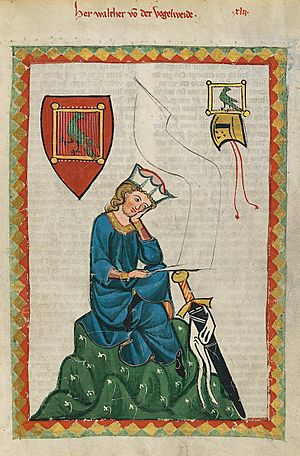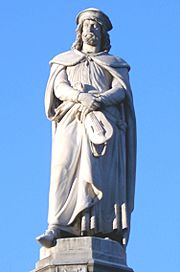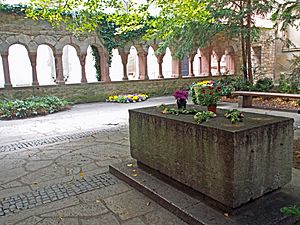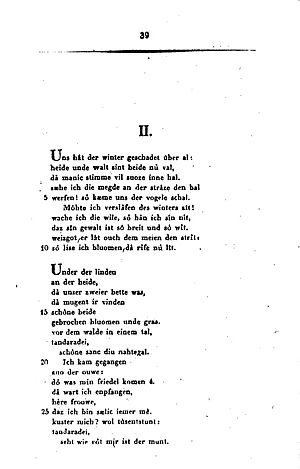Walther von der Vogelweide facts for kids

Walther von der Vogelweide (born around 1170, died around 1230) was a famous German poet and singer. He was a Minnesänger, which means he wrote and performed love songs. He also wrote political songs called "Sprüche" in Middle High German, an old form of German.
Many people think Walther was the best German poet before Goethe. His love songs are seen as the best examples of Minnesang, a style of medieval German love poetry. He made this style new and exciting. Walther was also the first German poet to write about politics. He wrote poems praising people, making fun of others, and sharing his moral ideas.
We don't know much about Walther's life. He traveled a lot, singing for powerful people at different royal courts in the Holy Roman Empire. He spent a lot of time at the court in Vienna. Later in his life, the future Holy Roman Emperor, Frederick II, gave him a small piece of land called a fief.
Walther's songs were very popular when he was alive and for many years after. Other singers, called Meistersingers, looked up to him. Because he was so famous, many of his songs were saved. We have his work in 32 old books called manuscripts. The biggest collection is in the Codex Manesse, which has about 90% of his known songs. However, most of these old books only have the words, and only a few of Walther's melodies (the tunes) have survived.
Some of his most famous songs are the love song "Under der linden", the thoughtful "Elegy", and the religious song Palästinalied. We still have the tune for the Palästinalied.
Contents
Walther's Life Story
Even though Walther was very famous, his name is not found in many old records. There is only one mention of him in the travel notes of a church leader named Bishop Wolfger of Erla. It says: "To Walther the singer of the Vogelweide five shillings for a fur coat." Most of what we know about him comes from his own poems and what other singers of his time said about him. He was a knight, but probably not a rich one who owned a lot of land. His last name, "von der Vogelweide," means "from the bird-pasture." This suggests he didn't own a specific piece of land. He was likely made a knight for being brave in battle and worked for a noble family before he started traveling.
Where Was Walther Born?
| Important Dates | |
|---|---|
| Around 1170 | Born |
| Around 1190 | Starts his singing career |
| Until 1198 | Sings for Duke Frederick I of Austria |
| 1198 | Leaves the Vienna court |
| 1198-1201 | Sings for King Philip of Swabia |
| 1200 | Maybe at Leopold VI's special event in Vienna |
| 1201 | Sings for Landgrave Hermann of Thuringia |
| 1203 | Maybe at Leopold's wedding in Vienna |
| 1204/05 | In Thuringia |
| 1212 | At a big meeting of Emperor Otto IV in Frankfurt |
| 1212/13 (or until 1216?) | Sings for Otto IV |
| 1212/13 | Sings for Margrave Dietrich of Meißen |
| From late 1213 (1214?, 1216?) |
Sings for King Frederick II (who became Emperor in 1220) |
| From 1213/14 until April 1217 | Sings for Hermann of Thuringia |
| 1215/16? | At the court of Duke Bernard II of Carinthia |
| 1216/17 | In Vienna |
| 1219 | In Vienna |
| 1220 | At a big meeting of Frederick II in Frankfurt |
| 1220 | Gets a fief (land) from Frederick II |
| After 1220 | At the court of Count Diether II of Katzenellenbogen |
| From 1220 (1224?) until 1225 |
Sings for Archbishop Engelbert of Cologne |
| 1224 (or 1225?) | At a big meeting in Nürnberg |
| Around 1230 | Died |
No one knows exactly where Walther was born. His name "von der Vogelweide" doesn't help much because there were many "bird-pastures" near castles and towns back then. These were places where people caught birds.
One idea is that he was born in a place called the Waldviertel in Austria. In 1974, a farmhouse called "Vogelweidhof" was found there. Walther himself said, "In Austria, I learned to sing and to speak." This could mean he learned his skills there. Some people also thought he was from Bohemia, which is close to the Waldviertel.
Another idea from 1987 points to a village called "Walthers" and a field named "Vogelwaidt" near Allentsteig on an old map. This area is also in the Waldviertel.
However, some people, like Franz Pfeiffer, believed Walther was born in South Tyrol, in a place called Wipptal. There's a wood there called "Vorder- and Hintervogelweide." But this idea doesn't fit with Walther saying he couldn't visit his homeland for many years.
Learning and Traveling
Walther learned to sing and write poetry from a famous master named Reinmar the Old. He was very sad when Reinmar died and wrote two beautiful poems about it. Walther's first supporter was Duke Frederick I of Vienna, whose court was a center for poetry and art.
This happy time ended when Duke Frederick died in 1198. After that, Walther became a traveling singer. He went from one court to another, singing for food and a place to stay. He hoped someone important would give him a permanent home so he wouldn't have to live like a "juggler." He didn't own much and relied on others.
Walther was very honest in his poems, often criticizing people and their ways. Sometimes, this made the people he sang for, or their staff, want him to leave.
Walther and Politics
Walther had strong opinions, especially about politics. When Emperor Henry VI died in 1197, a big fight started between the empire and the papacy (the Pope's power). Walther strongly supported German independence and unity. Even though he was a faithful Catholic, he disagreed with the Pope's extreme demands. He attacked the popes fiercely because he cared so much about his country.
His political poems started in 1198 in Vienna. He asked Germany to stop its princes from causing trouble. He wanted Philip to be crowned emperor and bring peace. Walther was at Philip's crowning in Mainz in 1198 and supported him until Philip won.
After Philip was murdered in 1208, Walther supported Otto of Brunswick against Frederick of Hohenstaufen, who was supported by the Pope. Only after Otto lost power in the Battle of Bouvines (1214) did Walther turn to Frederick, who was now the main leader against the Pope and the princes.
Finally, Emperor Frederick recognized Walther's talent and his strong support for the empire. He gave Walther a small piece of land in Franconia. Walther complained it wasn't much, but it gave him the home he had always wanted. It's not clear if Frederick also made Walther a teacher to his son, Henry (VII). Walther's poems suggest it, but it's not certain. Walther didn't stay on his new land for long. He was a restless spirit.
Later Years and Death
In 1217, Walther was back in Vienna. He was there again in 1219 after Duke Leopold VI returned from a crusade (a religious war). Around 1224, he seems to have settled on his land near Würzburg. He encouraged German princes to join the crusade of 1228. He might have gone with the crusading army at least as far as his home region of Tirol. In one poem, he describes how much his childhood home had changed, making it feel like a dream.
Walther died around 1230. He was buried in Würzburg. The story goes that he asked for birds to be fed at his tomb every day. His first gravestone is gone, but in 1843, a new monument was put up in the spot, which is now called the Lusamgärtchen ("Little Lusam Garden").
Walther's Manuscripts
Walther's work was saved much better than that of other poets from his time. We have over 30 complete books and pieces of old books (manuscripts) that contain his songs. The biggest collections are in four main Minnesang manuscripts:
- MS A (the Kleine Heidelberger Liederhandschrift) has 151 songs under Walther's name.
- MS B (the Weingarten Manuscript) has 112 songs under Walther's name.
- MS C (the Große Heidelberger Liederhandschrift, also known as the Manesse Codex) has the most, with 440 songs.
- MS E (the Würzburg Manuscript) has 212 songs under Walther's name.
Manuscripts B and C even have pictures showing Walther in a pose he described in one of his poems: "I sat upon a stone."
Many other manuscripts have smaller numbers of his songs. Sometimes, pages are missing from the sections about Walther, meaning some of his work is lost.
Most of these old books were made at least two generations after Walther died, mainly in the 1300s or 1400s. One exception is MS M (the Carmina Burana), which might have been put together when Walther was still alive.
Walther's Melodies
Like most singers of his time, very few of Walther's melodies (the tunes for his songs) have survived. We know of some tunes from three main sources:
- The 14th-century Münster Fragment (MS Z) has the complete melody for the Palästinalied. It also has parts of melodies for two other political songs.
- The Meistersingers (later German singers) wrote down some melodies they said were Walther's.
- Some of Walther's songs have the same rhythm and structure as French songs from his time. This means he might have used the tunes from those French songs for his own words. These are the only possible melodies for his love songs.
Walther's Legacy
How People Saw His Work

A writer named Gottfried von Strassburg, who lived at the same time as Walther, said that Walther was the "leader" of the Minnesingers after Reinmar died. Gottfried could judge Walther's skills as a composer and performer. He wrote about Walther's amazing voice and how he changed his singing.
Today, experts still think Walther's work is very important.
Remembering Walther
In 1889, a statue of Walther was put up in a square in Bolzano, Italy. The square was then named "Walther von der Vogelweide-Platz." Later, the statue was moved, but it was put back in its original spot in 1981.
There are two statues of Walther in fountains in Würzburg, Germany. One is near the Würzburg Residence, and another is in the Walther-Schule (Walther School). You can also find statues of him in Weißensee (Germany), Sankt Veit an der Glan and Innsbruck (Austria), and Duchcov in the Czech Republic.
- Statues
-
The Franconia Fountain, Würzburg, Germany
-
Fountain on main square in Sankt Veit an der Glan, Austria
-
Statue in the Waltherpark, Innsbruck, Austria
Besides his grave in Würzburg, there are other memorials to Walther. These include places like the Knüll-Storkenberg nature reserve in Halle (Westfalia), Herlheim (Franconia), the Walhalla memorial near Regensburg, Lajen in South Tyrol, Zwettl, Gmunden, and the ruined Mödling Castle in Austria.
- Memorials
Some schools are named after him in Bozen, Aschbach-Markt, and Würzburg.
About His Works
Many scholars have studied and published Walther's works. This shows how important he is in literature. When people talk about Walther's songs, they often use "Lachmann numbers." These numbers, like "L39,11," refer to the page and line number in an important edition of his poems from 1827 by Karl Lachmann. This helps everyone find the same song easily.
 In Spanish: Walther von der Vogelweide para niños
In Spanish: Walther von der Vogelweide para niños
- Albrecht von Johansdorf
- Individual songs:
- Ir sult sprechen willekomen
- Palästinalied
- Under der linden














